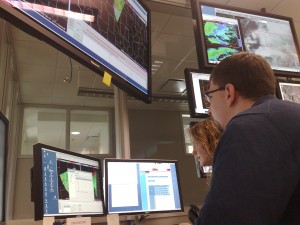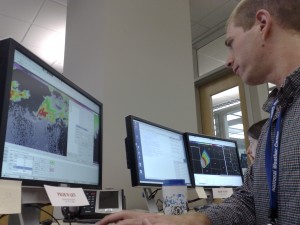Our first week of “operations” has completed, our operational shakedown week. We conducted our first end-of-week debriefing with a large group of NWC participants. Some of the highlights:
We discussed how to hold these end-of-week debriefings. They will include:
- A daily debriefing of Thursday operations.
- Scientific and technological discussion about the various projects.
- Logistical concerns of the visiting participants.
- Overall discussion on how we might improve the experience for all participants.
We also had a discussion on how we will introduce the visitors to the experiment at the orientation seminar. One particular item of note was to point out that we are running a research experiment, and that we should all expect bugs, kinks, and wrinkles. The forecaster/evaluators should look beyond those and focus on the bigger picture, to the future of NWS warning operations and technologies.
We finished the meeting with a lengthy discussion on the gridded probabilistic warning experiment.
One suggestion was to suggest at the orientation seminar that the forecasters should divorce themselves of the non-meteorological factors that effect their warning decision making, for example:
- Not getting verification due to low population.
- Letting certain users or subsets of users dictate your meteorological decisions.
- Turn off the county and city overlays…
…and focus on the science and meteorology!
Some discussion on what metrics we might measure included:
- Lead time for each event at different probability thresholds versus deterministic polygon. Can use LSRs, or hail tracks/rotation tracks for time of arrival/departure.
- Kristin talked to Harold Brooks, who suggested the forecasters, when issuing their warnings, treat our initial probability plateau as the probability of an event within the initial threat area, and not within x distance from the grid point. We can do that kind of analysis after the fact with the collected data.
Finally, we discussed the kinds of feedback we might seek from the forecasters. I’ve summarized the discussion:
1. Evaluate the concept of continuously advecting threat areas
- How do we define the initial threat area?
- Equitable lead time
- Canceling out back of threat with time
- Maintaining the threats during lifetime of storm
2. Provide feedback on the science of adding uncertainty information to warnings.
- What baseline probabilities relate to today’s storm-based warnings?
- How do we calibrate these probabilities over time?
- Using algorithms to offer probabilistic guidance as a “first guess�
- How does enhanced verification (SHAVE reports) affect your WDM?
3. Assess the scientific and technological concepts before they are implemented into the NWS Next-Generation Warning Tool (NGWT).
Kiel added a “check box” to the polygon GUI that a forecaster could check when they think the current threat area that they are warning has now reached their “internal criteria” for issuing a storm-based warning of today. There was mixed reaction to that idea, but most folks generally felt it was ok to leave that there.
Here are some various images from the week. Most of the folks working this week were our future weekly coordinators and cognizant scientists, getting training on the various system and acting as “forecaster/evaluators”. Their comments and suggestions have been very helpful.
Greg Stumpf (EWP Weekly Coordinator, 21-25 April)



